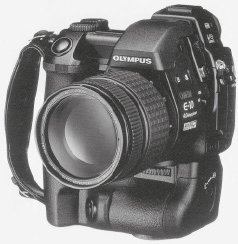articles/Cameras/hitchhicker-page2
The Hitchhiker's Guide to...Digital Pictures - part 2 of 1 2 3
by Tom Lee Published 01/02/2001

The Camedia E10.....
So, what do you get for your investment, apart from a box that's very difficult to open! The first thing you notice is that it has a style of its own which looks the business and although totally new, has a familiar feel about it which is very reassuring. Weighing about 1kg, its all aluminium body has a quality build and more to the point, includes a non-removable zoom lens equivalent to 35 - 140mm in 35mm format.
Additional afocal (front end) attachments can be purchased separately. Whilst this may not sound exciting, it means the lens can be converted up to an equivalent 450mm for just £699 if required, whilst retaining fast aperture settings (f2.8). Impressive eh! How much will you pay for a Nikon lens of that focal length and speed?
The other thing that makes this camera different is that there is no old technology built into the camera.
With the Nikon, Fuji or Canon models, the electronics were designed to fit into existing body chassis so that existing lens systems could be used with them.
One of the big drawbacks with this approach is that existing lens technology is just not up to it. Existing optics have been designed to make best use of film characteristics, which are totally different to capturing images on a digital chip. This results in only the middle part of the lens being effective. Olympus have started with a clean slate, and designed a totally new lens to take advantage of the small chip size, making the whole package more efficient. This is how they can achieve ultra fast lenses by using the afocal extensions. The whole of the lens area is effective in light capture, making for better detail in the shadow areas, and with the added benefit of reduced "noise" and better colour rendition.
The basic kit also includes a 16 megabyte smart media card, lens hood, software, strap and a remote control unit which allows you to fire the shutter and also control the zoom function of the lens. The built in flash unit also covers the entire lens range up to 5m (the length of a living room).
I have chosen to buy the optional side grip and rechargeable lithium battery pack which bumps the price up, but is well worth it as anybody who has used digital cameras knows, they eat batteries before breakfast is over. Also purchased was an additional 64 megabyte smartmedia card, enough to handle a large wedding. At approximately 1mb per image this card, with the one supplied, enables something like 80 images to be stored in High Quality mode.
The all up cost of the equipment is £2200 including VAT (inclusive of LiPo battery, Charger, Pro grip, additional memory card and card reader. Don't forget the system is complete with the 35-140mm zoom lens) The cheapest advertised price for the other cameras (body only) is for the Canon D30 at £2200 Ex VAT, Fuji S1 Pro £2300 Ex VAT and the Nikon D1 at £3200 Ex VAT
Measuring up.....
I'm a great believer in knowing well what I need to know, and knowing where to find what I don't need to know. Many cameras come with all singing, all dancing wotnots, and you probably only use about four of its functions regularly. Olympus has not incorporated some of the more advanced features of its contemporaries, which has undoubtedly helped in reducing the purchase price down to a manageable level. Apart from some obvious differences, it has most of the functions that standard 35mm cameras have (ie aperture priority, shutter priority, focus lock etc.....). The zoom lens covers most of the jobs that you will undertake without having to buy lens attachments for the time being. My Met flash gun works quite happily in auto mode when attached to the PC sync socket in all speeds up to 1/640th of a second (which incidentally is its top shutter speed). This is no disadvantage to most of us that have been stuck on 1/500th with medium format gear.
Equivalent ISO speeds of 80, 160 and 340 are achievable which again covers most eventualities, and images are captured on a 4 megapixel chip. (actual capture of 3.67mp, because some pixels are used for other purposes) This is a true capture resolution and not interpolated which Fuji insist on stating for their camera.
Please Note:
There is more than one page for this Article.
You are currently on page 2
- The Hitchhiker's Guide to...Digital Pictures page 1
- The Hitchhiker's Guide to...Digital Pictures page 2
- The Hitchhiker's Guide to...Digital Pictures page 3
1st Published 01/02/2001
last update 09/12/2022 14:54:58
More Cameras Articles
There are 60 days to get ready for The Society of Photographers Convention and Trade Show at The Novotel London West, Hammersmith ...
which starts on Wednesday 14th January 2026





